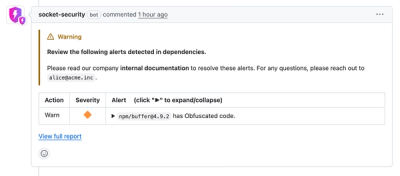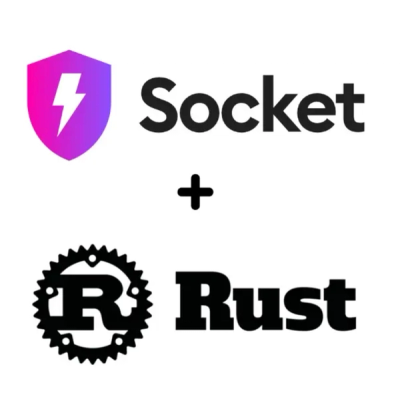
Security News
Crates.io Users Targeted by Phishing Emails
The Rust Security Response WG is warning of phishing emails from rustfoundation.dev targeting crates.io users.
web-neurosdk-brainbit
Advanced tools
BrainBit EEG Headset JavaScript Library (using Web Bluetooth)
WEB Bluetooth API requires HTTPS
npm install
webpack
npm install web-neurosdk-brainbit
Usage:
import BrainbitClient from 'web-neurosdk-brainbit';
var brainbitClient = new BrainbitClient();
const connect = async () => {
brainbitClient.connectionStatus.subscribe((status) => {
console.log(status ? 'Connected!' : 'Disconnected');
});
try {
await brainbitClient.connect();
brainbitClient.statusData.subscribe((data) => {
console.log('statusData', data);
});
brainbitClient.eventMarkers.subscribe((event) => {
console.log(event);
});
brainbitClient.eegStream.subscribe((data) => {
console.log(data);
});
brainbitClient.resistanceData.subscribe((data) => {
console.log(data);
});
} catch (err) {
console.error('Connection failed', err);
}
};
const startEEG = () => {
const startEEGStatus = await brainbitClient.startEEGStream();
console.log('current status', startEEGStatus);
};
async connect()
is used for device connection. It returns a Promise that resolves to true or false value.async checkStatus()
checks the current status. It returns a Promice that resolves to the object with the next fields:{
status: {
{
name: 'string', // status name, one of NSS2_STATUS_INVALID, NSS2_STATUS_STOPED, NSS2_STATUS_SIGNAL, NSS2_STATUS_RESIST, NSS2_STATUS_BOOTLOADER_NEED
value: 0, // status number
message: 'string', // status description
}
},
cmdError: {
name: 'string', // error name, one of NSS2_ERROR_NOERROR, NSS2_ERROR_LEN, NSS2_ERROR_MODE
value: 0, // error number
message: 'string', // error message
},
batteryCharge: 45, // batary charge in %
firmwareVersion: 8
}
async startEEGStream() starts EEG stream. It returns a Promice that resolves to the Status object with the next fields: {
name: 'NSS2_STATUS_SIGNAL',
value: 2,
message: 'Signal measurement started'
}
async stopEEGStream() stops EEG stream. It returns a Promise that resolves to the Status object.async startResistanceData() starts resistance measuring, it returns a Promise that resolves to the Status object.async stopResistanceData() stops resistance measuring, it returns a Promise that resolves to the Status object.async deviceInfo() returns a Promise that resolves to deviceInfoObject with the next fields:model
hardwareRevision
firmwareVersion
name
deviceId
state (CONNECTED | DISCONNECTED)
disconnect() disconnects bluetooth device.There are some Observable properties for subscribing to receive data.
brainbitClient.eegStream.subscribe((data) => {
console.log(data);
});
EEG Data Object
{
number: int, // a number of a data packet
marker: boolean,
val0_ch1: float, // the first value of the channel 1
val0_ch2: float, // the first value of the channel 2
val0_ch3: float, // the first value of the channel 3
val0_ch4: float, // the first value of the channel 4
val1_ch1: float, // the second value of the channel 1
val1_ch2: float, // the second value of the channel 2
val1_ch3: float, // the second value of the channel 3
val1_ch4: float, // the second value of the channel 4
}
brainbitClient.resistanceData.subscribe((data) => {
console.log(data);
});
Resistance Data Object
{
resistanceCh1: float, // measured resistance value
resistanceCh2: float,
resistanceCh3: float,
resistanceCh4: float
}
brainbitClient.statusData.subscribe((data) => {
console.log('statusData', data);
});
Status Data Object
{
status: {
{
name: 'string', // status name, one of NSS2_STATUS_INVALID, NSS2_STATUS_STOPED, NSS2_STATUS_SIGNAL, NSS2_STATUS_RESIST, NSS2_STATUS_BOOTLOADER_NEED
value: 0, // status number
message: 'string', // status description
}
},
cmdError: {
name: 'string', // error name, one of NSS2_ERROR_NOERROR, NSS2_ERROR_LEN, NSS2_ERROR_MODE
value: 0, // error number
message: 'string', // error message
},
batteryCharge: 45, // batary charge in %
firmwareVersion: 8
}
For convenience, there is an eventMarkers stream included in BrainbitClient that you can use in order to introduce timestamped event markers into your project. Just subscribe to eventMarkers and use the injectMarker method with the value and optional timestamp of an event to send it through the stream.
async function main() {
let client = new brainbitClient();
client.eventMarkers.subscribe((event) => {
console.log(event);
});
client.injectMarker("thought")
client.injectMarker("one")
client.injectMarker("smile")
}
FAQs
BrainBit EEG Headset JavaScript Library (using Web Bluetooth)
We found that web-neurosdk-brainbit demonstrated a not healthy version release cadence and project activity because the last version was released a year ago. It has 1 open source maintainer collaborating on the project.
Did you know?

Socket for GitHub automatically highlights issues in each pull request and monitors the health of all your open source dependencies. Discover the contents of your packages and block harmful activity before you install or update your dependencies.

Security News
The Rust Security Response WG is warning of phishing emails from rustfoundation.dev targeting crates.io users.

Product
Socket now lets you customize pull request alert headers, helping security teams share clear guidance right in PRs to speed reviews and reduce back-and-forth.

Product
Socket's Rust support is moving to Beta: all users can scan Cargo projects and generate SBOMs, including Cargo.toml-only crates, with Rust-aware supply chain checks.